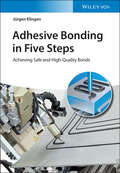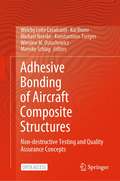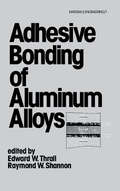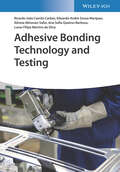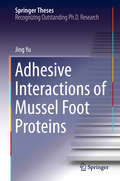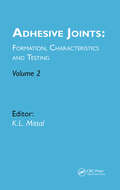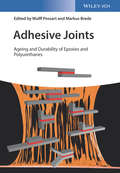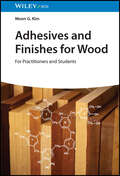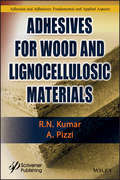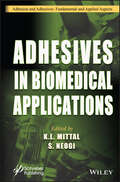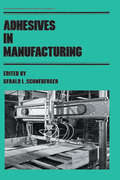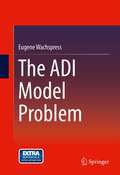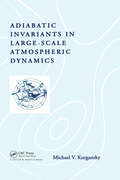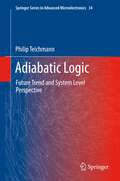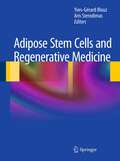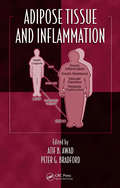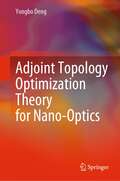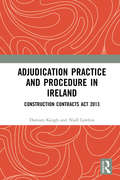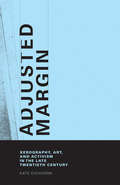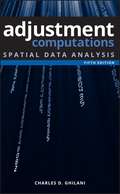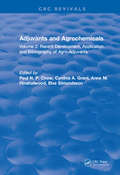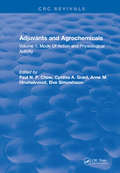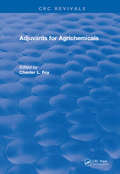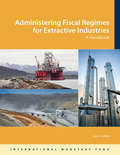- Table View
- List View
Adhesive Bonding in Five Steps: Achieving Safe and High-Quality Bonds
by Jürgen KlingenA comprehensive guide to successfully complete any adhesive bonding project In Adhesive Bonding in Five Steps: Achieving Safe and High Quality Bonds, accomplished chemist Dr. Jürgen Klingen delivers a thorough and practical overview of the adhesive concepts necessary for readers to design and sketch foundational steps in projects involving adhesive bonding. Readers will learn the complex considerations necessary for a successful adhesive bonding process from inception to completion. Dividing the adhesive bonding project into five clearly defined phases—planning, substrate concept, adhesive concept, feasibility, and development—the author demonstrates how to adhere to quality requirements while completing the reader’s own adhesive bonding processes. The book focuses on the treatment of the material surfaces to be bonded, the selection of suitable adhesives, the dimensioning of the bond, and the process steps for metering/mixing and curing the adhesives. The book also offers: A thorough introduction to the art and science of adhesive bonding, including adhesives, adhesive bonds, bonding in industry and craft, and an example of adhesive bonding in nature Comprehensive explorations of the history of adhesive bonding technology and wetting, adhesion, and cohesion Practical discussions of the necessary steps to achieving safe and high-quality adhesive bonds, including gate reviews and the DIN 2304 In-depth examinations of contemporary adhesive bonding applications, including examples in lightweight construction, modern façade construction, and low-energy plastics Perfect for engineers, engineering scientists, polymer chemists, and process engineers, Adhesive Bonding in Five Steps: Achieving Safe and High Quality Bonds will also prove to be an invaluable addition to the libraries of materials scientists and surface chemists.
Adhesive Bonding of Aircraft Composite Structures: Non-destructive Testing and Quality Assurance Concepts
by Welchy Leite Cavalcanti Kai Brune Michael Noeske Konstantinos Tserpes Wiesław M. Ostachowicz Mareike SchlagThis book is open access under a CC BY 4.0 license. It presents the results of the ComBoNDT European project, which aimed at the development of more secure, time- and cost-saving extended non-destructive inspection tools for carbon fiber reinforced plastics, adhered surfaces and bonded joints. The book reports the optimal use of composite materials to allow weight savings, reduction in fuel consumptions, savings during production and higher cost efficiency for ground operations.
Adhesive Bonding of Aluminum Alloys
by ThrallThis single-source reference is designed for anyone who is responsible for selecting the bestsurface treatment and a compatible adhesive for a particular design.Filled with over 300 photos, figures, and tables, Adhesive Bonding of Aluminum Alloyspresents clear analytical methods for examining the adequacy of bonded joints ... methodsfor chemical analysis of an adhesive and primer ... specific instructions on how to anodizealuminum alloys for three different surface treatments .. . recommended primers foranodized alloys ... examples that help you verify fail-safe capacity ... and more.In addition, this guide gives you the latest chemical analysis methods for control, proventest procedures for mechanical durability properties, a wide selection of nondestructive inspectionprocedures, and numerous surface analysis methods.Adhesive Bonding of Aluminum Alloys can be of immediate assistance to materials, mechanical,design, process, manufacturing, automotive, aeronautical, corrosion, and maintenanceengineers; designers and manufacturers of primary and secondary aluminum structures;adhesive scientists; testing and material specialists; and upper-division undergraduateand graduate-level researchers in materials, aeronautical design, and adhesive science.
Adhesive Bonding Technology and Testing
by Ana Sofia Queiros Ferreira Barbosa Lucas Filipe da Silva Ricardo Joao Camilo Carbas Eduardo Andre Sousa Marques Alireza Akhavan-SafarAdhesive Bonding Technology and Testing Comprehensive resource that provides insight into the purpose and design of experiments for adhesive bonding, joint design and strength prediction This book provides support for those practicing and teaching adhesive bonding and enables them to understand and design laboratorial courses and experiments. To aid in reader comprehension and information retention, a selected set of problems with corresponding solutions is included, which helps readers to develop a deep understanding of the subject matter. Written by five highly qualified professionals in the field of adhesive bonding, sample topics covered in the book include: Practical demonstrations of adhesive bonding, plus discussion on the advantages and disadvantages of the technique Detailed laboratorial activities that pertain to adhesive bonding The manufacturing of defect-free bonded joints The effects of geometry and materials properties in adhesive joint testing, surface preparation, joint design, and strength prediction This book is an essential resource for chemists, engineers, and students/instructors in related programs of study who wish to conduct better and more efficient experiments that pertain to adhesive bonding and related concepts.
Adhesive Interactions of Mussel Foot Proteins (Springer Theses)
by Jing YuWater and moisture undermine strong adhesion to polar surfaces. Marine mussels, however, achieve durable underwater adhesion using a suite of proteins that are peculiar in having high levels of 3, 4-dihydroxyphenylalanine (Dopa). Mussel adhesion has inspired numerous studies on developing the next generation of wet adhesives. This thesis presents recent progress in understanding the basic surface and intermolecular interactions employed by mussels to achieve strong and durable wet adhesion. The surface forces apparatus (SFA) and various other techniques were applied to measure the interactions between mussel foot protein-3 fast (Mfp-3 fast) and the model substrate, mica, as well as the interactions between various mussel adhesive proteins The results in this thesis show that Dopa plays an essential role in mussel adhesion and that mussels delicately control the interfacial redox environment to achieve strong and durable Dopa mediated adhesion. The interplay between Dopa and hydrophobic interactions is also evident in mussel adhesion.
Adhesive Joints: Volume 2
by K. L. MittalThis volume documents the proceedings of the Second International Symposium on Adhesive Joints: Formation, Characteristics and Testing held in Newark, NJ, May 22-24, 2000. Since the first symposium, held in 1982, there had been tremendous research activity dealing with many aspects of adhesive joints.This volume contains a total of 21 papers, which were all properly peer reviewed, revised and edited before inclusion. Therefore, this book is not merely a collection of unreviewed manuscripts, but rather represents information which has passed peer scrutiny. Furthermore, the authors were asked to update their manuscripts, so the information contained in this book should be current and fresh.The book is divided into three parts: 1) General Papers; 2) Evaluation, Analysis and Testing; and 3) Durability Aspects. The topics covered include: molecular brush concepts in enhancing strength of adhesive joints; factors affecting performance of adhesive joints; substrate preparation and modification; interfacial/interphasial aspects; determination of locus of failure; analysis and evaluation of adhesive joints using various techniques; testing of adhesive joints; stress analysis; application of fracture mechanics; durability aspects; accelerated environmental degradation of adhesive joints; solvent uptake; and adhesives with special characteristics.This volume represents a commentary on the current R&D activity in this arena and it should be of great value and interest to anyone interested in adhesive bonding / adhesive joints. Furthermore, this volume contains a number of excellent review/overview articles, which should be of particular value.
Adhesive Joints: Ageing and Durability of Epoxies and Polyurethanes
by Wulff Possart Markus BredeA comprehensive overview of adhesive bonding, providing both basic knowledge of polymer adhesives as well as insights into their mechanical and ageing properties. The book is unique in its up-to-date, self-contained summary of recent developments and in its integration of the theory, synthesis and mechanical properties of adhesive joints as well as their applications. Well-structured throughout, the first chapter introduces the initial state of adhesive joints and their formation, while subsequent chapters discuss the ageing and failure as well as the weathering of adhesive joints. In addition the issue of long-term behavior and lifetime predictions are considered. The text is rounded off by a look at future technological advances. The result is an essential reference for a wide range of disciplines
Adhesive Particle Flow
by Jeffrey S. Marshall Shuiqing LiOffering a comprehensive treatment of adhesive particle flows, this book adopts a particle-level approach oriented toward directly simulating the various fluid, electric field, collision, and adhesion forces and torques acting on the particles, within the framework of a discrete-element model. It is ideal for professionals and graduate students working in engineering and atmospheric and condensed matter physics, materials science, environmental science, and other disciplines where particulate flows have a significant role. The presentation is applicable to a wide range of flow fields, including aerosols, colloids, fluidized beds, and granular flows. It describes both physical models of the various forces and torques on the particles as well as practical aspects necessary for efficient implementation of these models in a computational framework.
Adhesives and Finishes for Wood: For Practitioners and Students
by Moon G. KimAdhesives and Finishes for Wood Understand the science of joining wood with this comprehensive guide Long seen as an old-fashioned material with narrowing modern applications, wood has seen increased popularity as a material in building and manufacturing in recent years. This has been driven by the need for sustainable resources and environmentally friendly materials. As a result of increased emphasis on wood, however, there is a corresponding need to understand the wood adhesives, the crucial materials in wood-based manufacture and craftsmanship. Adhesives and Finishes for Wood meets this need with a comprehensive but accessible introduction to the chemistry and applications of wood adhesives. Its easy-to-follow presentation nonetheless presents wood adhesives and finishes in significant detail. Ideal for readers without considerable preexisting knowledge in chemistry, this book includes everything the reader needs to understand and apply wood adhesives in their work or industry. Adhesives and Finishes for Wood readers will also find: Coverage ranging from the fundamentals of wood adhesive polymer chemistry to the properties of specific wood structures and resins A presentation suitable for both academic students and wood manufacture professionals An author with decades of experience in both academia and industry Adhesives and Finishes for Wood is a useful reference for advanced students and professionals in industries or manufacturing disciplines that incorporate wood, as well as for chemists, materials scientists, vocational school instructors, and more.
Adhesives for Wood and Lignocellulosic Materials
by R. N. Kumar A. PizziThe book is a comprehensive treatment of the subject covering a wide range of subjects uniquely available in a single source for the first time. A material science approach has been adopted in dealing with wood adhesion and adhesives. The approach of the authors was to bring out hierarchical cellular and porous characteristics of wood with polymeric cell wall structure, along with the associated non-cell wall extractives, which greatly influence the interaction of wood substrate with polymeric adhesives in a very unique manner not existent in the case of other adherends. Environmental aspects, in particular formaldehyde emission from adhesive bonded wood products, has been included. A significant feature of the book is the inclusion of polymeric matrix materials for wood polymer composites.
Adhesives in Biomedical Applications (Adhesion and Adhesives: Fundamental and Applied Aspects)
by K. L. Mittal S. NeogiADHESIVES IN BIOMEDICAL APPLICATIONS Uniquely provides up-to-date and comprehensive information on adhesives in biomedical applications in an easily accessible form. Adhesives are gaining popularity in many and varied biomedical applications as they are being used as a replacement for sutures and staples, which have the disadvantages such as scarring, infection, keloid formation, poor skin healing, or hernia in the case of abdominal sutures. On the other hand, adhesives dramatically reduce healthcare costs, significantly reduce time spent in surgery, curb the risks of bleeding, and are generally easy to use. Adhesives also find their use in diagnostic imaging, various biomedical devices, dental adhesives, dermal adhesives, etc. Adhesives in Biomedical Applications contains eleven chapters and is divided into two parts: Part 1: General Topics; and Part 2: Specific Adhesives, Characteristics, and Applications. Topics covered include: historical developments of various adhesives for biomedical applications; global industry development and analysis of adhesives for biomedical applications; biomedical adhesives; bioadhesion: fundamentals and mechanisms; fibrin glue; herbal bioactives-based mucoadhesive drug delivery systems; adhesive hydrogels; adhesives in dermal patches; medical adhesives from extracted mussel adhesive proteins; dental adhesives; and the role of adhesive-based systems for diagnostic imaging and theranostic applications. Audience The book will be used by adhesionists, adhesive technologists, polymer scientists, materials scientists, as well as those involved with biomedical devices and bioimplants such as medical doctors, surgeons, cosmetologists, as well as engineers in the pharmaceutical industry.
Adhesives in Manufacturing
by SchnebergerThis book provides an exhaustive range of detailed, easy-access information required to initiate or improve an adhesive bonding operation in a modern industrial environment. Featuring recent developments and more than 400 photos, figures, and tables, this practical reference is the most comprehensive up-to-date book available. Designed for engineers and technicians confronting everyday problems of selections, surface preparation, applications, and curing, this book progresses from fundamental concepts to all types of adhesives, bonding techniques, and performance, durability, and testing of bonds, including such areas as acrylic and urethan adhesives, and water-based systems.
The ADI Model Problem
by Eugene WachspressThe ADI Model Problem presents the theoretical foundations of Alternating Direction Implicit (ADI) iteration for systems with both real and complex spectra and extends early work for real spectra into the complex plane with methods for computing optimum iteration parameters for both one and two variable problems. This book provides application of theory to the solution of boundary value problems and description of stable similarity reduction of a full matrix to low-band upper Hessenberg form, with application to computation of eigenvalues and solution of Lyapunov and Sylvester equations. Also included are MATLAB programs and numerical verification of theory and applications.
Adiabatic Invariants in Large-Scale Atmospheric Dynamics
by Michael V. KurganskyAdiabatic Invariants in Large-Scale Atmospheric Dynamics deals with the main principles of large-scale atmospheric dynamics on the basis of adiabatic motion constants. It introduces the theory of quasi two-dimensional fluid motion, concentrating primarily on nearly horizontal fluid parcel displacements in a stably stratified compressible fluid. Coverage also includes a complete set of compressible fluid dynamic equations along with a survey of fluid dynamical conservation laws used in meteorology and atmospheric physics; the derivation of two-dimensional atmospheric models; and the principles of kinetic energy sinks and their relation to the energy balance in the atmosphere.
Adiabatic Logic: Future Trend and System Level Perspective (Springer Series in Advanced Microelectronics #34)
by Philip TeichmannAdiabatic logic is a potential successor for static CMOS circuit design when it comes to ultra-low-power energy consumption. Future development like the evolutionary shrinking of the minimum feature size as well as revolutionary novel transistor concepts will change the gate level savings gained by adiabatic logic. In addition, the impact of worsening degradation effects has to be considered in the design of adiabatic circuits. The impact of the technology trends on the figures of merit of adiabatic logic, energy saving potential and optimum operating frequency, are investigated, as well as degradation related issues. Adiabatic logic benefits from future devices, is not susceptible to Hot Carrier Injection, and shows less impact of Bias Temperature Instability than static CMOS circuits. Major interest also lies on the efficient generation of the applied power-clock signal. This oscillating power supply can be used to save energy in short idle times by disconnecting circuits. An efficient way to generate the power-clock is by means of the synchronous 2N2P LC oscillator, which is also robust with respect to pattern-induced capacitive variations. An easy to implement but powerful power-clock gating supplement is proposed by gating the synchronization signals. Diverse implementations to shut down the system are presented and rated for their applicability and other aspects like energy reduction capability and data retention. Advantageous usage of adiabatic logic requires compact and efficient arithmetic structures. A broad variety of adder structures and a Coordinate Rotation Digital Computer are compared and rated according to energy consumption and area usage, and the resulting energy saving potential against static CMOS proves the ultra-low-power capability of adiabatic logic. In the end, a new circuit topology has to compete with static CMOS also in productivity. On a 130nm test chip, a large scale test vehicle containing an FIR filter was implemented in adiabatic logic, utilizing a standard, library-based design flow, fabricated, measured and compared to simulations of a static CMOS counterpart, with measured saving factors compliant to the values gained by simulation. This leads to the conclusion that adiabatic logic is ready for productive design due to compatibility not only to CMOS technology, but also to electronic design automation (EDA) tools developed for static CMOS system design.
Adipose Stem Cells and Regenerative Medicine
by Aris Sterodimas Yves-Gerard IllouzThe therapeutic potential of the use of adipose stem cells in regenerative medicine has been increasingly recognized, and in recent years concrete clinical benefits have accrued as these cells have been explored for a variety of applications. This readable and informative textbook tracks the progress that has been made in this fascinating new area of biomedicine. All aspects of the subject are considered, with particular attention to adipose cell biology, adipose tissue engineering strategies, and the diverse clinical applications of adipose stem cells. Funding issues, industrial approaches, regulatory challenges, and future directions are also examined. The two editors have vast experience in the field and have chosen leading experts from different countries to write on each topic. This book will excite the interest of all researchers, clinicians, and students wishing to gain an in-depth understanding of adipose stem cells and their flourishing role in regenerative medicine.
Adipose Tissue and Inflammation (Oxidative Stress and Disease)
by Atif B. Awad Peter G. BradfordThe American Obesity Association identifies obesity's link to numerous medical conditions, including hypertension, type 2 diabetes, cardiovascular disease, several cancers, and a host of inflammatory disorders. Evidence indicates that inflammation has more than a corollary relation with obesity; that in fact, obesity itself manifests a low-grade, m
Adjoint Topology Optimization Theory for Nano-Optics
by Yongbo DengThe book focuses on the topology optimization method for nano-optics. Both principles and implementing practice have been addressed, with more weight placed on applications. This is achieved by providing an in-depth study on the major topic of topology optimization of dielectric and metal structures for nano-optics with extension to the surface structures for electromagnetics. The comprehensive and systematic treatment of practical issues in topology optimization for nano-optics is one of the major features of the book, which is particularly suited for readers who are interested to learn practical solutions in topology optimization. The book can benefit researchers, engineers, and graduate students in the fields of structural optimization, nano-optics, wave optics, electromagnetics, etc.
Adjudication Practice and Procedure in Ireland: Construction Contracts Act 2013
by Damien Keogh Niall LawlessThis adjudication textbook uniquely brings together a comprehensive analysis of, and commentary on, the Construction Contracts Act 2013 with a real-world perspective of adjudication, considering the knowledge, process and skills parties and adjudicators require in order to successfully participate in the adjudication process. Drawing on combined experience of 40 years in construction law, the authors provide invaluable guidance for all stakeholders in the adjudication process. The authors analyse and comment on the adjudication provisions of the Construction Contracts Act and describe prudent practice and procedure required to comply with Irish adjudication law, including case studies, case law and sample documentation for those to be involved as the parties, or those who want to act as adjudicators. Aimed at contractors, sub-contractors, developers, employers, construction, engineering and legal professionals and students, all of whom are either involved, or have an interest, in dispute resolution and adjudication.
Adjusted Margin: Xerography, Art, and Activism in the Late Twentieth Century
by Kate EichhornHow xerography became a creative medium and political tool, arming artists and activists on the margins with an accessible means of making their messages public. This is the story of how the xerographic copier, or “Xerox machine,” became a creative medium for artists and activists during the last few decades of the twentieth century. Paper jams, mangled pages, and even fires made early versions of this clunky office machine a source of fear, rage, dread, and disappointment. But eventually, xerography democratized print culture by making it convenient and affordable for renegade publishers, zinesters, artists, punks, anarchists, queers, feminists, street activists, and others to publish their work and to get their messages out on the street. The xerographic copier adjusted the lived and imagined margins of society, Eichhorn argues, by supporting artistic and political expression and mobilizing subcultural movements. Eichhorn describes early efforts to use xerography to create art and the occasional scapegoating of urban copy shops and xerographic technologies following political panics, using the post-9/11 raid on a Toronto copy shop as her central example. She examines New York's downtown art and punk scenes of the 1970s to 1990s, arguing that xerography—including photocopied posters, mail art, and zines—changed what cities looked like and how we experienced them. And she looks at how a generation of activists and artists deployed the copy machine in AIDS and queer activism while simultaneously introducing the copy machine's gritty, DIY aesthetics into international art markets.Xerographic copy machines are now defunct. Office copiers are digital, and activists rely on social media more than photocopied posters. And yet, Eichhorn argues, even though we now live in a post-xerographic era, the grassroots aesthetics and political legacy of xerography persists.
Adjustment Computations
by Charles D. Ghilanithe complete guide to adjusting for measurement error--expanded and updatedno measurement is ever exact. Adjustment Computations updates a classic, definitive text on surveying with the latest methodologies and tools for analyzing and adjusting errors with a focus on least squares adjustments, the most rigorous methodology available and the one on which accuracy standards for surveys are based.This extensively updated Fifth Edition shares new information on advances in modern software and GNSS-acquired data. Expanded sections offer a greater amount of computable problems and their worked solutions, while new screenshots guide readers through the exercises. Continuing its legacy as a reliable primer, Adjustment Computations covers the basic terms and fundamentals of errors and methods of analyzing them and progresses to specific adjustment computations and spatial information analysis. Current and comprehensive, the book features:Easy-to-understand language and an emphasis on real-world applicationsAnalyzing data in three dimensions, confidence intervals, statistical testing, and moreAn updated support web page containing a 150-page solutions manual, software (STATS, ADJUST, and MATRIX for Windows computers), MathCAD worksheets, and more at http://www.wiley.com/college/ghilaniThe latest information on advanced topics such as the tau criterion used in post-adjustment statistical blunder detectionAdjustment Computations, Fifth Edition is an invaluable reference and self-study resource for working surveyors, photogrammetrists, and professionals who use GNSS and GIS for data collection and analysis, including oceanographers, urban planners, foresters, geographers, and transportation planners. It's also an indispensable resource for students preparing for licensing exams and the ideal textbook for courses in surveying, civil engineering, forestry, cartography, and geology.
Adjuvants and Agrochemicals: Volume 2: Recent Development, Application, and Bibliography of Agro-Adjuvants
by Paul N. ChowStudies of Adjuvants involve many scientific fields from basic research of the chemistry, through investigations into physiological effects and environmental impact, to mixture formulation and field use. These important areas are illustrated in these two volumes, which are contributions from the First International Symposium on Adjuvants for Agrochemicals, held in Brandon, Manitoba on August 5 to 7, 1986. A total of 200 participants from 19 countries met to discuss their common interest in adjuvant science, technology, and application. It is the editors hope that these volumes will stimulate interest in and promote a better understanding of the chemical, physiological, and agronomic aspects of adjuvants as they relate agrochemicals. In addition, the revisedAdjuvants for Agrochemicals: A Selected Bibliography of World Literature in the English Language will be a valuable resource for agricultural researchers and other users. We hope that adjuvant research will lead to even safer, more efficient, and more economical use of chemicals in agriculture and forestry.
Adjuvants and Agrochemicals: Volume 1: Mode Of Action and Physiological Activity
by Paul N. ChowStudies of Adjuvants involve many scientific fields from basic research of the chemistry, through investigations into physiological effects and environmental impact, to mixture formulation and field use. These important areas are illustrated in these two volumes, which are contributions from the First International Symposium on Adjuvants for Agrochemicals, held in Brandon, Manitoba on August 5 to 7, 1986. A total of 200 participants from 19 countries met to discuss their common interest in adjuvant science, technology, and application. It is the editors hope that these volumes will stimulate interest in and promote a better understanding of the chemical, physiological, and agronomic aspects of adjuvants as they relate agrochemicals. In addition, the revisedAdjuvants for Agrochemicals: A Selected Bibliography of World Literature in the English Language will be a valuable resource for agricultural researchers and other users. We hope that adjuvant research will lead to even safer, more efficient, and more economical use of chemicals in agriculture and forestry.
Adjuvants for Agrichemicals
by Chester L. FoyBased on a conference, this book is intended to promote a better understanding of the effects of adjuvants on pesticide penetration, translocation, photodegradation and stability, spray deposition and dissipation, and the fate of herbicides in the environment.
Administering Fiscal Regimes for Extractive Industries: A Handbook
by Jack CalderA report from the International Monetary Fund.
